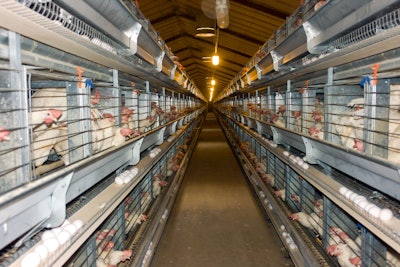
Environmental management is crucial to preventing dust, ammonia and pathogens from spreading throughout layer farms.
“With these large layer operations, we do see challenges” from an environmental management point of view, including highly pathogenic avian influenza (HPAI), climate change and variability and air pollutant emissions that affect indoor environment and health, said Lingying Zhao, professor and associate director, The Ohio State University.
During the Georgia Layer Conference on September 25, Zhao shared the results of three research studies that evaluated the effectiveness of novel layer house environmental management tools.
1. Spray wet scrubber
Wet scrubbing technology can recover ammonia emissions produced on layer farms. However, the packed-bed wet scrubbers currently in use in Europe cause high back pressure on fans, which means they will not work with the fans currently in use on U.S. poultry farms.
In research funded by the U.S. Department of Agriculture (USDA), Zhao’s team developed an acid spray wet scrubber that has an ammonia removal efficiency of 63-81% at 100-400 ppm inlet ammonia concentrations.
Wet scrubbers work by using water and/or chemicals to “scrub” air pollutants from the air streams leaving poultry buildings. The prototype model also produces a scrubbing effluent liquid that can be used as fertilizer.
2. Electrostatic precipitation air cleaning
Dust is a major hazard in poultry barns, primarily originating from feed, animal dander, feathers and manure. Electrostatic technology is one innovation in development that could improve dust control in layer houses.
This technology charges liquids as they pass through a sprayer nozzle, resulting in droplets that repel each other and instead seek out surfaces. One of the biggest benefits of electrostatic technology is that it produced a uniform coating that avoids the liquid pooling often associated with trigger sprays.
There are some challenges associated with electrostatic technology in promptly removing dust particles that have settled onto indoor surfaces, which reduces dust control efficiency, Zhao said.
3. Upward airflow displacement ventilation
Ventilation plays an important role in reducing or preventing the effects of excessive heat, moisture and air pollutants and pathogens in layer houses. In this research conducted at a commercial poultry farm, Zhao’s team aimed to develop a new ventilation system specifically designed for manure-belt layer houses.
Compared to tunnel ventilation, upward airflow displacement ventilation supplies air underneath each layer cage to both dry the manure and supply fresh air to the layer house. This can help result in a more uniform environment when it comes to temperature, reducing the incidence of heat stress.


















